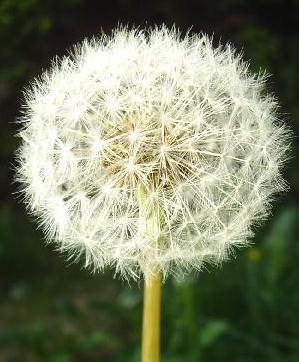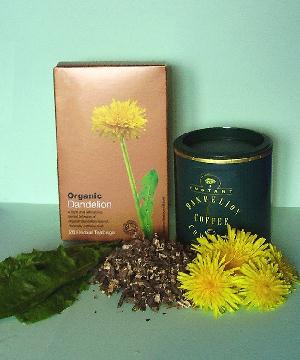Dandelion
By Debs Cook
During a trip to my local garden centre recently, I overheard a couple of ladies discussing the best way to deal with the problem of dandelions in their gardens. The assistant offered them a list of 'products' that would help them eradicate the weed! Weed?! Why do we give one of the most versatile and useful of our wild herbs such an unworthy title? I couldn't resist taking the ladies to one side and waxing lyrical about the many uses the dandelion could be put to.
The encounter left me wondering what if Wordsworth had written,
I Wandered lonely as a cloud
That floats on high o'er vales and hills,
When all at once I saw a crowd,
A host, of golden dandelions"?
Okay it doesn't rhyme, but would the image of this much maligned herb now be different? Would the dandelion be the herald of spring and the daffodil the pernicious weed?

In the hedgerows, roadside verges, fields and meadows across the UK, the golden heads of the dandelion are in abundance from late March through to October. So, as they're easily identifiable and can be put to so many uses, I thought I would do my bit to put the dandelion firmly back on the map of useful herbs.
History
The dandelion family were first mentioned in China in the Tang Materia Medica back in the 7th century. In the 11th century, the Arabian physician, Avicenna, cited its use as a plant that would gradually restore health. By the 13th century dandelions were being used by the physicians of Myddfai to treat jaundice, in a remedy that also contained Corn Blue Bottle (Centaurea cyanus), Garden Parsley (Petroselinum crispum) and old English ale.
Incidentally in Welsh the dandelion is called Dant y llew.
During the medieval period, most physicians treated their patients using the Doctrine of Signatures. For those that don't know, this doctrine states that herbs have been 'signed' by God. Their appearance and characteristics thus revealed clues to their medicinal use. For example, yellow coloured plants were linked to diseases with a yellow hue, such as jaundice.
In 17th century Culpeper had the dandelion down as an herb of Jupiter and spoke of its uses as a cleanser of the liver and spleen and for treating conditions of the urinary tract amongst other things. Matthew Robinson in his 'Family Herbal' says, "The Dandelion is a most useful herb, and ought to be more extensively known, on account of its tonic, alterative, diaphoretic, and diuretic properties." Since Robinson's time, the dandelion has featured in just about every herbal written in countries all over the world, including Indian and Russia.
Folklore

The name dandelion is a derivation of the Old French, dent-de-lion, literally "lion's tooth", because it was thought that the toothed leaves of the dandelion resembled lion's teeth.
As a child I remember being terrified of going anywhere near a dandelion as my aunt frequently told me that merely touching the plants would make me 'pee-the-bed'. So this is what I called the dandelion throughout my childhood. Talking to others it seems that each region has its own variation on the pee-the-bed name, what's yours? The name variations also carry overseas; in Italy the folk name is 'Meacamas', in Spain 'Piscialetto' and in France 'Pissenlit'. Other names for the dandelion that aren't so earthy include Clockflower, Tell-The-Time, Blowball, Puffball, Priest's Crown and Swine Snout.
The dandelion makes an excellent barometer, when the flowers have seeded and are in their fluffy stage, you can tell if the weather is going to be fair or foul. In fine weather the ball extends to full, but when rain approaches, it shuts like an umbrella. If the weather is inclined to be showery it keeps shut all the time, only opening when the danger from the rain is past.
The plant is sacred to St Bridget and the milky white sap that comes from the stems is said to nourish lambs and calves. It is also supposed to rid a person of warts. According to an oldwives tale, the seeds can help determine how long you have left to live; blow once on the seed head of a dandelion, how long you have left to live is determined by the number of seeds that are left on the head. If you'd rather know the time than your mortality, blow three times on the seed head. The number of seeds left is the hour, although I'm not certain if the time will be GMT or BST.
Description
The dandelion is a member of the Asteraceae family, and is a native of both Europe and Asia, but is also found in Canada, New Zealand, Russia, Australia and the USA. The dandelion is perennial and has tap roots. Above the root sits a rosette of leaves that can grow up to 30cm long. The leaves are bright green with uneven, jagged margins of backward pointing indentations. The green colouring of the dandelion leaves changes from pale lime green to a darker green as the plant ages. The stems of the dandelion are hollow and are crowned with a single yellow flower, which after a few days turns into a ghostly globe of delicate feathery seeds or, as they're correctly called in the world of botany. achenes. These seeds resemble fluffy little parachutes that blow into the air with the gentlest of breezes, carrying each seed away to new places.
There are some 250 species of Taraxacum on record in the British Isles alone. Added to those are the White Flowered Dandelion (Taraxacum albidum), native to Japan, and also the Japanese Dandelion (Taraxacum japonicum). There is also the Red Seeded Dandelion (Taraxacum laevigatum), which is found in places around the UK.
Growing
Hands up all those of you who as children delighted in blowing on the dandelion clocks to tell the time; enjoying the sight of the little fluffy parachutes spinning through the air on a warm Summers day? That's how easy it is to propagate dandelions; so simple a child can do it! The problem is the little fluffy parachutes may end up in other people's gardens, where they're not wanted. Propagation is by seed, and yes you can buy packets of dandelion seed. Dandelion will grow under almost all conditions, thriving in dry areas, just as well as wet.

Medicinal Use
Dandelions have diuretic, laxative, tonic, stomachic, antioxidant, hepatic and anti-inflammatory properties. They are rich in minerals such as potassium, zinc and calcium and some of their main constituents are inulin, levulin, choline, taraxacin, mucin and saponins.
A cup of dandelion root tea or coffee a day, or the consumption of the leaves, is recommended for anyone with liver complaints. The green leaves are a valuable alkali for the body; eaten regularly they assist in the reduction of excess acid. Dandelion has been found to sooth the digestive tract, absorb toxins from the bowel, help friendly flora to thrive and stem the production of unfriendly bacteria. Dandelion is also helpful for people who suffer from skin conditions, such as eczema. It can be used to treat asthma, arthritis, rheumatism, low blood pressure, poor circulation, ulcers, anemia, constipation, colds, heart burn, hot flushes, and can even be used to help bring on sleep at bedtime.
Culinary Use
This plant really does have some wonderful uses in the kitchen. It is a good source of vitamins A, B1, B2, B3, C and E to start with. Dandelion is the perfect partner to burdock in that classic drink dandelion and burdock. It was a favourite of mine as a child and it still is today. My Great Grandfather used to make dandelion beer, although being a child I never got to sample it, so don't know what it tasted like. I do know from grown up experience, that dandelions make a light and refreshing country wine, if you use the fresh flowers.
The leaves make a good tonic tea, whilst the roots make a rather nice, caffeine free coffee substitute. The young raw leaves can be used in salads or cooked as a vegetable, like spinach. Dandelion leaves actually contain more iron than spinach, would you believe? The Victorians grew dandelion in their kitchen gardens as a salad vegetable for use in soups and broths.
Finally
There we have it; I hope that this article has tempted those that don't value the dandelion to look at it with new eyes? I'm now off out into the garden to pick some dandelion leaves to mix in with my lunchtime salad. Whilst I'm there I may sit a while with a cup of dandelion coffee and see if my garden offers up some inspiration for next month's article.
Acknowledgement
Grateful thanks go to Gill Swan for answering my query on how the Physicians of Myddfai used dandelion.
